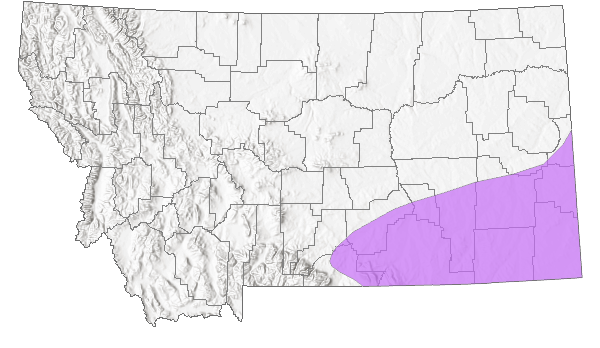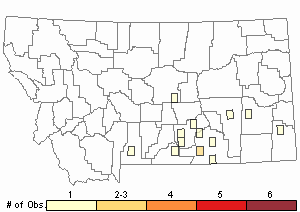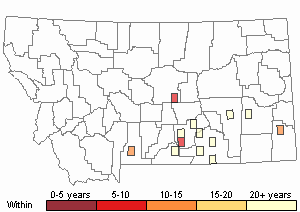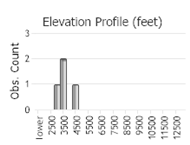View in other NatureServe Network Field Guides
NatureServe
Montana
Utah
Wyoming
Idaho
Wisconsin
British Columbia
South Carolina
Yukon
California
New York
Riverbank Grape - Vitis riparia
Native Species
Global Rank:
G5
State Rank:
S3S4
(see State Rank Reason below)
C-value:
5
Agency Status
USFWS:
USFS:
BLM:
External Links
State Rank Reason (see State Rank above)
Vitis riparia grows in riparian and woody draw habitats and on fences in a small portion of Montana. More current data on population size, distribution, and threats is needed before warranting it as a Species of Concern.
- Details on Status Ranking and Review
Range Extent
ScoreF - 20,000-200,000 sq km (~8,000-80,000 sq mi)
Area of Occupancy
ScoreD - 6-25 4-km2 grid cells
Number of Populations
ScoreB - 6 - 20
Environmental Specificity
ScoreC - Moderate. Generalist or community with some key requirements scarce
Long-term Trend
ScoreU - Unknown
Trends
ScoreU - Unknown
Threats
ScoreD - Low
CommentThreat categories include: Ecosystem modifications.
Intrinsic Vulnerability
ScoreBC - Moderately vulnerable to not intrinsically vulnerable
General Description
Plants: Woody vines (Lesica 2012), climbing or spreading up to 25 m, the bark typically coming loose and falling off in peels (McGregor et al. 1986).
Leaves: Leaves long-petiolate, alternate; blades cordate-ovate, palmately and shallowly lobed, glabrous above, puberulent on veins below, 5–12 cm in length (Lesica 2012), width similar to length, basal sinus wide; margins with wide, acuminate teeth; teeth sometimes with 1 or both sides concave (McGregor et al. 1986); tendrils branched, opposite the upper leaf axils, without adhesive disks (Lesica 2012).
Inflorescence: A branched panicle from upper leaf nodes (Lesica 2012), compact, 4-12 cm in length, axis minutely hairy to nearly smooth (McGregor et al. 1986).
(Lesica’s contribution adapted from
Lesica et al. 2012. Manual of Montana Vascular Plants. BRIT Press. Fort Worth, TX)
Phenology
Flowers May-June. Fruits July-September (McGregor et al. 1986).
Species Range
Montana Range
Range Descriptions

 Native
Native
Range Comments
MT to QC south to NM, TX and TN (Lesica et al. 2012. Manual of Montana Vascular Plants. BRIT Press. Fort Worth, TX).
Observations in Montana Natural Heritage Program Database
Number of Observations: 45
(Click on the following maps and charts to see full sized version)
Map Help and Descriptions
Relative Density

Recency



 (Observations spanning multiple months or years are excluded from time charts)
(Observations spanning multiple months or years are excluded from time charts)
Habitat
Riparian forest; plains (Lesica 2012), thickets, creek banks, lush woodlands (McGregor et al. 1986).
(Lesica’s contribution from
Lesica et al. 2012. Manual of Montana Vascular Plants. BRIT Press. Fort Worth, TX)
Ecology
POLLINATORS The following animal species have been reported as pollinators of this plant species or its genus where their geographic ranges overlap:
Bombus griseocollis (Colla and Dumesh 2010).
Reproductive Characteristics
Flowers: Functionally unisexual, 5-merous; calyx reduced, faintly lobed; petals separate, early deciduous; stamens 5; ovary superior; style 1 (Lesica 2012).
Fruit: A purple, globose berry, glaucous, 7–11 mm across, 2-celled with 2 seeds per cell (Lesica 2012); seeds reddish-brown, 4.5-5.5 mm in length (McGregor et al. 1986).
(Lesica’s contribution adapted from
Lesica et al. 2012. Manual of Montana Vascular Plants. BRIT Press. Fort Worth, TX)
Management
Sometimes cultivated for its autumn leaf colors, Riverbank Grape may escape or persevere after other traces of human occupation have disappeared (Hitchcock et al. 1961).
Stewardship Responsibility
References
- Literature Cited AboveLegend:
 View Online Publication
View Online Publication Colla, S.R. and S. Dumesh. 2010. The bumble bees of southern Ontario: notes on natural history and distribution. Journal of the Entomological Society of Ontario 141:39-68.
Colla, S.R. and S. Dumesh. 2010. The bumble bees of southern Ontario: notes on natural history and distribution. Journal of the Entomological Society of Ontario 141:39-68. Hitchcock, C. L., A. Cronquist, M. Ownbey, and J. W. Thompson. 1961. Vascular Plants of the Pacific Northwest, Part 3. Saxifragaceae to Ericaceae. Seattle, WA and London, England: University of Washington. 614 pp.
Hitchcock, C. L., A. Cronquist, M. Ownbey, and J. W. Thompson. 1961. Vascular Plants of the Pacific Northwest, Part 3. Saxifragaceae to Ericaceae. Seattle, WA and London, England: University of Washington. 614 pp. Lesica, P., M.T. Lavin, and P.F. Stickney. 2012. Manual of Montana Vascular Plants. Fort Worth, TX: BRIT Press. viii + 771 p.
Lesica, P., M.T. Lavin, and P.F. Stickney. 2012. Manual of Montana Vascular Plants. Fort Worth, TX: BRIT Press. viii + 771 p. McGregor, R.L. (coordinator), T.M. Barkley, R.E. Brooks, and E.K. Schofield (eds). 1986. Flora of the Great Plains: Great Plains Flora Association. Lawrence, KS: Univ. Press Kansas. 1392 pp.
McGregor, R.L. (coordinator), T.M. Barkley, R.E. Brooks, and E.K. Schofield (eds). 1986. Flora of the Great Plains: Great Plains Flora Association. Lawrence, KS: Univ. Press Kansas. 1392 pp.
- Additional ReferencesLegend:
 View Online Publication
View Online Publication
Do you know of a citation we're missing? Boggs, K. W. 1984. Succession in riparian communities of the lower Yellowstone River, Montana. M.S. Thesis. Montana State University, Bozeman, 107 pp.
Boggs, K. W. 1984. Succession in riparian communities of the lower Yellowstone River, Montana. M.S. Thesis. Montana State University, Bozeman, 107 pp. DuBois, K.L. 1979. An inventory of the avifauna in the Long Pines of Southeastern Montana. M.Sc. Thesis. Bozeman, MT: Montana State University. 113 p.
DuBois, K.L. 1979. An inventory of the avifauna in the Long Pines of Southeastern Montana. M.Sc. Thesis. Bozeman, MT: Montana State University. 113 p. Eggers, M.J.S. 2005. Riparian vegetation of the Montana Yellowstone and cattle grazing impacts thereon. M.Sc. Thesis. Montana State University, Bozeman, MT. 125 p.
Eggers, M.J.S. 2005. Riparian vegetation of the Montana Yellowstone and cattle grazing impacts thereon. M.Sc. Thesis. Montana State University, Bozeman, MT. 125 p. Lesica, P., M.T. Lavin, and P.F. Stickney. 2022. Manual of Montana Vascular Plants, Second Edition. Fort Worth, TX: BRIT Press. viii + 779 p.
Lesica, P., M.T. Lavin, and P.F. Stickney. 2022. Manual of Montana Vascular Plants, Second Edition. Fort Worth, TX: BRIT Press. viii + 779 p.
- Web Search Engines for Articles on "Riverbank Grape"





